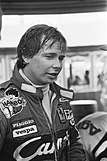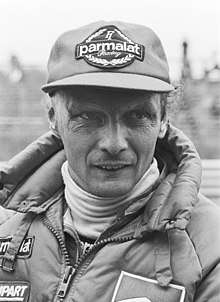1982 Formula One World Championship
The 1982 FIA Formula One World Championship was the 36th season of FIA Formula One motor racing. It featured the 1982 Formula One World Championship for Drivers and the 1982 Formula One World Championship for Constructors, which were contested concurrently over a sixteen-race series that began on 23 January and ended on 25 September. The Drivers' Championship was won by Keke Rosberg and the Constructors' Championship by Scuderia Ferrari.
| 1982 FIA Formula One World Championship |
|||
| Drivers' Champion: Keke Rosberg Constructors' Champion: Ferrari | |||
| Previous: | 1981 | Next: | 1983 |
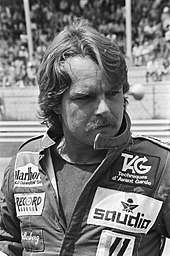

Motorsport journalist Nigel Roebuck later wrote that the 1982 season was "an ugly year, pock-marked by tragedy, by dissension, by greed, and yet, paradoxically, it produced some of the most memorable racing ever seen".[1] It started with a drivers' strike at the season opener in South Africa and saw a partial race boycott as part of the ongoing FISA–FOCA war at the San Marino Grand Prix. Two drivers lost their lives during the season: Gilles Villeneuve during qualifying for the Belgian Grand Prix and Riccardo Paletti at the start of the Canadian Grand Prix. Later, championship favourite Didier Pironi suffered a career-ending accident while qualifying for the German Grand Prix. These incidents and several other major accidents led to regulation changes to increase driver security for 1983.
Rosberg won only one race all season – the Swiss Grand Prix – but consistency gave him the Drivers' Championship, five points clear of Pironi and John Watson. Rosberg was the second driver to win the championship having won only one race in the season, after Mike Hawthorn in 1958. Eleven different drivers from seven different teams won a race during the season, with no driver winning more than twice; there was also a run of nine different winners in nine consecutive races from the Monaco Grand Prix to the Swiss Grand Prix. Ferrari, who replaced Villeneuve with Patrick Tambay and Pironi with 1978 World Champion Mario Andretti, managed to score enough points to secure the Constructors' Championship, finishing five clear of McLaren with Renault third.
Drivers and constructors
| Entrant | Constructor | Chassis | Engine | Tyres | No | Driver | Rounds |
|---|---|---|---|---|---|---|---|
| Brabham-BMW | BT50 | BMW M12/13 1.5 L4t | G | 1 | 1, 5–16 | ||
| 2 | 1, 5, 9–16 | ||||||
| Brabham-Ford | BT49C BT49D |
Ford Cosworth DFV 3.0 V8 | 1 | 2–3 | |||
| 2 | 2–3, 6–8 | ||||||
| Tyrrell-Ford | 011 | Ford Cosworth DFV 3.0 V8 | G | 3 | All | ||
| 4 | 1–3 | ||||||
| 4–16 | |||||||
| Williams-Ford | FW07C FW07D FW08 |
Ford Cosworth DFV 3.0 V8 | G | 5 | 1–2 | ||
| 3 | |||||||
| 5–16 | |||||||
| 6 | 1–3, 5–16 | ||||||
| McLaren-Ford | MP4/1B | Ford Cosworth DFV 3.0 V8 | M | 7 | 1–3, 5–16 | ||
| 8 | 1–3, 5–16 | ||||||
| ATS-Ford | D5 | Ford Cosworth DFV 3.0 V8 | A M |
9 | All | ||
| 10 | All | ||||||
| Lotus-Ford | 87B 91 |
Ford Cosworth DFV 3.0 V8 | G | 11 | 1–3, 5–16 | ||
| 12 | 1–3, 5–8, 10, 12–16 | ||||||
| 9 | |||||||
| 11 | |||||||
| Ensign-Ford | N180B N181 |
Ford Cosworth DFV 3.0 V8 | A M |
14 | 1–3, 5–16 | ||
| Renault | RE30B | Renault-Gordini EF1 1.5 V6t | M | 15 | All | ||
| 16 | All | ||||||
| March-Ford | 821 | Ford Cosworth DFV 3.0 V8 | P A |
17 | 1–3, 5–11 | ||
| 12–16 | |||||||
| 18 | 1–3, 5–16 | ||||||
| 19 | 5–9 | ||||||
| Fittipaldi-Ford | F8D F9 |
Ford Cosworth DFV 3.0 V8 | P | 20 | 1–3, 5–16 | ||
| Alfa Romeo | 179D 182 182B |
Alfa Romeo 1260 3.0 V12 Alfa Romeo 890T 1.5 V8t |
M | 22 | All | ||
| 23 | All | ||||||
| Ligier-Matra | JS17B JS19 |
Matra MS81 3.0 V12 | M | 25 | 1–3, 5–16 | ||
| 26 | 1–3, 5–16 | ||||||
| Ferrari | 126C2 | Ferrari 021 1.5 V6t | G | 27 | 1–5 | ||
| 9–16 | |||||||
| 28 | 1–12 | ||||||
| 15–16 | |||||||
| Arrows-Ford | A4 A5 |
Ford Cosworth DFV 3.0 V8 | P | 29 | 1–3 | ||
| 5–16 | |||||||
| 30 | 1–3, 5–16 | ||||||
| Osella-Ford | FA1C FA1D |
Ford Cosworth DFV 3.0 V8 | P | 31 | All | ||
| 32 | 1–8 | ||||||
| Theodore-Ford | TY01 TY02 |
Ford Cosworth DFV 3.0 V8 | A G |
33 | 1–3 | ||
| 5–7, 9–11 | |||||||
| 8 | |||||||
| 12–16 | |||||||
| Toleman-Hart | TG181B TG181C TG183 |
Hart 415T 1.5 L4t | P | 35 | 1–6, 9–16 | ||
| 36 | 1–6, 9–16 | ||||||
| Source:[2] | |||||||
Team changes
All teams and constructors who had competed in 1981 returned for the new season. Brabham had entered a deal for engine supply with German car manufacturer BMW for the use of their L4 turbo engines. The team announced in January that they would only be using the new BMW engine,[3] but after experiencing reliability problems with the BMW engine, they reverted to using the Cosworth DFV engine several times during the season.[4]
Driver changes
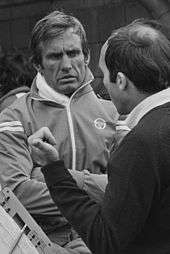
And the end of the 1981 season, both Williams drivers, 1980 world champion Alan Jones and Carlos Reutemann, had announced their retirement from racing.[5] Reutemann did in fact return for 1982,[6] competing in the first two races, before retiring unexpectedly at the end of March.[7] Jones was replaced by Keke Rosberg, who had previously entered 36 Grands Prix, but won none with only one podium finish to his name.[8] The off season saw rumours of several former champions returning to the sport,[lower-alpha 1] but in the end only double world champion Niki Lauda returned to Formula One after an absence of two years to partner John Watson at McLaren.[9] Ferrari and Renault retained their race-winning line ups of Gilles Villeneuve and Didier Pironi and Alain Prost and René Arnoux, respectively.[10] At Brabham, defending world champion Nelson Piquet remained with the team, now partnered by Riccardo Patrese, who moved from Arrows to replace Héctor Rebaque.[5] The Osella team gave Riccardo Paletti his Grand Prix début, while Toleman replaced Brian Henton with Teo Fabi, also a newcomer to Formula One.[11] Marc Surer was hired by Arrows, but broke both his feet in pre-season testing at Kyalami. He was set to be replaced by Patrick Tambay, who was then removed from the squad after taking part in the drivers' strike at that race and the car went to Henton.[12] Eliseo Salazar transferred from Ensign Racing to the ATS team.[13]
- Mid-season changes
Following Reutemann's retirement, Williams hired 1978 world champion Mario Andretti as a one-off replacement for the United States Grand Prix West.[7] Derek Daly then became the permanent second driver at the team, as Andretti had racing obligations in the United States to fulfill.[14] Andretti returned with Ferrari for the last two races of the season, replacing Pironi, who had suffered career-ending injuries at the German Grand Prix.[15] Villeneuve, who died following a crash in qualifying for the Belgian Grand Prix, was replaced by Tambay starting from the Dutch Grand Prix.[16] At Team Lotus, Nigel Mansell missed two races due to injuries from a crash in Canada. His substitute at the Dutch Grand Prix was Roberto Moreno, who failed to qualify.[17] Mansell attempted a comeback at Brands Hatch, but was again replaced at the French Grand Prix, this time by Geoff Lees.[18] An accident at the race in France led Jochen Mass, already deeply shaken by the fatal crash of Villeneuve, in which he was involved, to walk away from Grand Prix racing.[19] He was replaced at March by Rupert Keegan.[20] Swedish driver Slim Borgudd had moved from ATS to Tyrrell, but was forced to leave the team when his sponsorship money ran out.[21] Henton took his place from the Belgian Grand Prix onwards, as Surer returned to Arrows after his injuries had healed.[22]
Season calendar
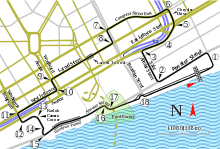
| Round | Grand Prix | Circuit | Date | |
|---|---|---|---|---|
| 1 | South African Grand Prix | 23 January | ||
| 2 | Brazilian Grand Prix | 21 March | ||
| 3 | United States Grand Prix West | 4 April | ||
| 4 | San Marino Grand Prix | 25 April | ||
| 5 | Belgian Grand Prix | 9 May | ||
| 6 | Monaco Grand Prix | 23 May | ||
| 7 | Detroit Grand Prix | 6 June | ||
| 8 | Canadian Grand Prix | 13 June | ||
| 9 | Dutch Grand Prix | 3 July | ||
| 10 | British Grand Prix | 18 July | ||
| 11 | French Grand Prix | 25 July | ||
| 12 | German Grand Prix | 8 August | ||
| 13 | Austrian Grand Prix | 15 August | ||
| 14 | Swiss Grand Prix | 29 August | ||
| 15 | Italian Grand Prix | 12 September | ||
| 16 | Caesars Palace Grand Prix | 25 September | ||
| Source:[23] | ||||
Calendar changes
The Argentine Grand Prix was scheduled to take place on 7 March, but was cancelled due to lack of sponsors, with several of them pulling out of financing the race due to uncertainty following the drivers' strike at the previous round at Kyalami.[24] The Spanish Grand Prix was omitted from the calendar for several reasons. The Circuito del Jarama, where the race had been held the previous year was unloved by drivers[25] and the organisers had failed to pay their fees for 1981.[26] The race was originally re-instated for 27 June after the organisers had paid their debts to the Formula One Constructors' Association (FOCA).[3][27] However, protests from the teams over the dangerous nature of the Jarama venue led to the race to eventually be cancelled.[25]
Two races were added to the calendar compared to 1981, the Detroit Grand Prix and the Swiss Grand Prix, held at Dijon-Prenois in France, since motor racing is outlawed in Switzerland since the 1955 Le Mans disaster.[26][lower-alpha 2] The addition of Detroit meant that the United States hosted three Grands Prix, the only time one country had more than two races in one season.[29]
Background
Politics
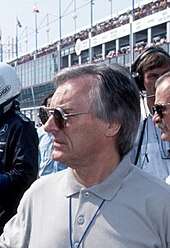
Starting in the early 1970s, Bernie Ecclestone, owner of the Brabham team, had seized control of the Formula 1 Constructors Association (F1CA), later renamed Formula One Constructors Association (FOCA). In this role, he began to negotiate more lucrative contracts between the teams and the track owners, including full control over television rights for FOCA.[30] Realising the growing influence of Ecclestone and FOCA, the sport's governing body, the Fédération Internationale de l'Automobile (FIA) and its head, Paul Metternich, instated Frenchman Jean-Marie Balestre as the head of the Commission Sportive Internationale (CSI) in 1978, which was then renamed to Fédération Internationale du Sport Automobile (FISA). The FISA was running the sporting regulations side of Formula One, delegated by the FIA.[31]
Over the following years, a power struggle developed between FOCA and FISA and Ecclestone and Balestre in particular. This conflict is generally referred to as the FISA–FOCA war.[32] FOCA consisted of the majorly British constructor teams, while the manufacturer or "works" teams (Renault, Ferrari, Alfa Romeo and Talbot-Ligier), together with Osella and Toleman were aligned with FISA.[33][lower-alpha 3]
The conflict came to a head at the 1980 Spanish Grand Prix, where the drivers of teams belonging to FOCA boycotted the obligatory drivers' briefing and were threatened by FISA with having their licences revoked. The race went ahead as a non-championship event, without the non-FOCA aligned teams participating.[30]
Following an aborted attempt to establish a break-away world championship, FOCA agreed to the Concorde Agreement with FISA in March 1981. This agreement stipulated that all teams were obliged to attend all rounds of the championship, while at the same time settling differences over future regulation changes.[30]
Regulation changes and technological development
Sporting regulations
The new rules for the season included an increase in the number of cars permitted to enter a Grand Prix from 30 to 34, and the number of starters from 24 to 26.[lower-alpha 4] To avoid having all 34 cars on the track at one time, a pre-qualifying session was introduced in which the three teams with the poorest record in the previous year would compete to be allowed into qualification proper. Just as the previous year, the best eleven results from all the races counted towards the Drivers' Championship.[34]
Technology
In the years leading up to 1982, two major technological developments had shaped Formula One: the turbocharged engine and "ground effect". In 1977, Lotus had revolutionised aerodynamics in Formula One by introducing the Lotus 78, known as the "wing car".[35] The car used what is commonly referred to as "ground effect", with the physical principle applied being the "Venturi effect". The sides of the underside of the car would be shut off with skirts to trap the under-pressure airflow underneath the car, effectively "sucking" the vehicle to the ground.[36] This led to increased cornering speeds, but at the same time brought implications that had an adverse effect on the drivers' safety. Moveable skirts were thus banned in 1981, accompanied by a minimum ride height for the cars of 6 cm (2.4 in), targeted at minimising the "ground effect" and cut cornering speed.[37]
However, for 1982, both regulations were reversed as a result of the new Concorde Agreement.[34][38] The skirts around the underpart of the chassis, which locked the airflow underneath the car, necessitated very stiff suspensions to work properly.[34] This meant that every bump on track was putting enormous strain on the drivers, shaking them around in the cockpit. Additionally, the cornering speed and the resulting high g-forces put pressure on both the drivers and the cars' suspensions, making them prone to breaking.[39] The cars would also move up and down on the road, in an effect called "porpoising", making the cars very hard to control.[36] These adverse effects were particularly impactful at bumpy circuits, such as Jacarepaguá, where Riccardo Patrese retired due to exhaustion. Other drivers reported dizziness and blurred vision, making it hard to see while driving.[40]
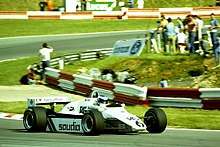
The potentially dangerous implications of "ground effect" were only worsened by the advent of very powerful turbocharged engines. In 1977, Renault had introduced the first turbocharged engine into the sport with their Renault RS01. The regulations at the time allowed for either three-litre normally aspirated or 1.5-litre turbocharged engines, with Renault being the first to attempt to go the latter route.[41] Over the next few seasons, the turbo engines proved fast, yet unreliable. By 1979, Renault had shown that races could be won with this formula, and in 1981, Ferrari had followed them by introducing their own turbo engine. The cars however still suffered an effect often labelled "throttle lag", meaning that a significant and indeterminable time gap existed between applying the throttle of the car and the point when the full power of the turbo was taking effect. This made the turbo cars very difficult to drive. The Toleman team also used turbo engines for 1982, supplied by Hart.[42]
Alfa Romeo retained what motorsport writer Doug Nye has called the most powerful three-litre engine seen in Formula One at that time, with 548 bhp (409 kW).[43] They tested their turbocharged V8 engine during practice for the Italian Grand Prix, but did not race it until the next season.[44] Most FOCA teams however still relied upon the Cosworth DFV engine, which had been introduced by Lotus in 1967.[45]
In 1981, McLaren had built the first car monocoque from carbon fibre composite. This allowed for cars to be lighter, while at the same time being more rigid. McLaren had proven that carbon-fibre cars could be quick, with John Watson winning the 1981 British Grand Prix. But maybe more importantly, Watson's uninjured escape from a severe accident at that year's Italian Grand Prix had shown the superiority of the material in terms of safety.[46] Lotus followed suit for 1982, introducing carbon fibre for their Lotus 91.[47]
Even with these effective technical advances in chassis design, the FOCA constructor teams still using the Cosworth DFV were at a significant power disadvantage compared to the turbocharged engines. To counteract this, the non-turbo teams used a loophole in the regulations. The weight of the car was measured before and after the race, with oil and cooling liquids allowed to be refilled before the final weigh-in. The teams would therefore build their cars lighter than allowed by the regulations and added water tanks, which they claimed were used to cool brake temperatures, but in reality the water was dumped on the track as soon as the car left the pitlane, allowing them to run faster.[24] Keke Rosberg later explained that "the water tank [...] was the one that gave us at least a theoretical chance to compete with the turbos."[48]
In other regulation changes, the minimum weight of the cars was reduced from 585 kg (1,290 lb) to 580 kg (1,280 lb). A new "driver survival cell" cockpit protection was made mandatory as well.[34]
Four companies, Goodyear, Michelin, Pirelli, and Avon, supplied tyres, including special qualifying tyres, which provided much increased levels of grip during the qualification sessions that determined the starting order for the race. These qualifying tyres had originally been banned in 1980, but had since been reallowed.[34] For the first time the number of tyres permitted for qualification was limited to two sets per session,[34] creating a situation which Villeneuve thought "...unnecessarily dangerous. If I have only two chances to set a time, I need a clear track, OK? If it isn't clear, if there's someone in my way, I just have to hope he's looking in his mirrors — I mean, I can't lift, because this is my last chance."[49] The necessity of having a clear track to make the most of the short-lasting qualifying tyres led to drivers taking risks, further increasing the danger while driving during the 1982 season.[34]
Season report
Pre-season
The week before the first Grand Prix of the season in South Africa, going into race week itself, testing for the season was conducted at the Kyalami circuit. Alain Prost set the fastest time during testing, at 1:05.71, almost eight seconds quicker than the previous track record. Marc Surer broke his feet during the testing sessions and was due to be replaced by Patrick Tambay at the Arrows team.[50] Jochen Mass also crashed in his March 821, but escaped uninjured. Ferrari did not have their new car, the 126C2, ready for testing and ran an updated version of their 1981 vehicle, the 126CK, instead. The Brabham team were satisfied with the progress of their new BT50 with the turbo-charged BMW engine.[13]
Championship
Opening rounds
Before the start of the season, all drivers had received a letter from FISA, containing an application form for a new Super Licence. This new document stated that drivers would not be allowed to switch teams freely during the course of the season, with their licence withdrawn should they do so. Additionally, the document forbade drivers from actions "which might harm the moral or material interests" of Formula One.[51] The returning Lauda was displeased by this and communicated with Didier Pironi, head of the Grand Prix Drivers' Association (GPDA). They contacted other drivers and ultimately, six drivers refused to sign the document, those being Lauda, Pironi, Villeneuve, Arnoux, Bruno Giacomelli and Andrea de Cesaris.[52]
On the Wednesday between testing and the first practice session, during a meeting of the Formula One Commission, Pironi, on behalf of the drivers, objected to the licence application. Balestre reacted strongly, excluding all drivers who had not signed from the following day's practice session. The drivers in turn reacted by going on strike the next day, boarding a bus to a nearby hotel.[lower-alpha 5] The conflict continued until the next day, the Friday before the race was set to take place. It was partially resolved shortly before noon that day, with the drivers receiving half-hearted assurances towards their demands. They would ultimately be fined $5,000 each for the strike, with the new Super Licence being scrapped.[54][55] Following the events in South Africa, the GPDA disbanded at a driver meeting in Paris, being replaced by the Professional Racing Drivers' Association (PRDA).[27]
When qualifying finally commenced, Arnoux took pole position from Piquet, with Villeneuve and Patrese on the second row of the grid. At the start, Arnoux led while Piquet did not get away well and was overtaken by several cars, including Prost, who jumped from fifth to second. Piquet and Villeneuve retired early, while Prost took the lead from his teammate Arnoux on lap 14. He would lead until lap 41, when he punctured his left rear tyre, forcing him to come into the pitlane for new tyres. He emerged in eighth place, but with this fresh set, Prost was the quickest driver on the course, allowing him to overtake relatively easily. On lap 68, he once again took the leading position from Arnoux and went on to win the race. Reutemann also overtook Arnoux late in the race and finished second, with Lauda in fourth place on his return to Formula One racing.[56][57][58]
The teams then moved to Brazil for the second round. Brabham abandoned their turbo-charged BT50 for now, reverting to an updated BT49D for this race, powered by the Cosworth DFV engine.[59] The cars once again proved just how quick they had become, when Prost qualified on pole position 6.27 seconds faster than Piquet had done the year before.[60] Villeneuve was second on the grid and went into the lead at the start, followed by Rosberg, with the two Renault drivers behind. However, Rosberg fell back behind the Renaults on the first lap and was overtaken by Patrese on lap three and by Piquet two laps later. Villeneuve led until lap 30, when he spun out. This allowed Piquet into the lead, closely followed by Rosberg, with the two having battled for position during the preceding laps. The order remained to the finish, with Piquet winning from Rosberg, Prost, Watson and Mansell.[61][62]
The heavy strain posed onto the drivers by the bumpy circuit and hot, humid weather was showcased not only by Patrese retiring on lap 34 due to exhaustion, but also when Piquet fainted on the winners' rostrum.[63] Following the race, both Ferrari and Renault protested the first- and second-place finishes of Piquet and Rosberg, citing the water tanks used by Brabham and Williams to be illegal. The case was taken to the FISA in Paris, with no outcome until after the next race.[64]
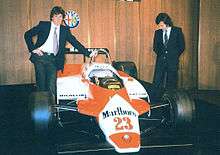
The third race of the season took place at the street circuit in Long Beach. During Saturday's qualifying, Lauda did just one run of a few laps, setting a fast time that put him on top of the leaderboard. However, in the closing seconds of the session, Andrea de Cesaris bettered Lauda's time, clinching pole position for Alfa Romeo. De Cesaris had been ousted by McLaren for Lauda over the winter and was moved to tears by his accomplishment.[65]
De Cesaris led from the start, while Lauda was overtaken by Arnoux for second place. On lap six, Giacomelli, running fourth, tried to outbrake Lauda and in the process hit Arnoux, forcing both to retire. This allowed Villeneuve into third place, ahead of Watson. Pironi and Prost both retired after hitting the wall on laps seven and eleven respectively. On lap 15, Lauda took advantage of de Cesaris missing a gear change and moved into the lead, immediately beginning to pull away. Rosberg overtook Villeneuve for third on lap 21. This turned into second place on lap 34, when de Cesaris crashed into the wall after his engine had failed. The order remained until the chequered flag, with Lauda winning in only his third Grand Prix back in the sport.[65][66] Villeneuve was later excluded from the results in Long Beach, following a protest by Ken Tyrrell over Ferrari's use of a double rear wing.[67]
In the week before the next round, the San Marino Grand Prix, the FIA International Court of Appeal sided with Ferrari and Renault on their complaint over the water tanks at the race in Brazil and disqualified Piquet and Rosberg, handing victory to Prost. It was further decided that the cars would now be weighed after the race in the condition in which they had finished, eliminating the Cosworth-powered teams' use of water tanks to increase their performance.[68] Notably however, all other runners' results from the Brazilian Grand Prix were upheld, including John Watson's, who inherited second place even though his car had been as illegal as the others.[69][70] The FOCA teams requested a postponement of the next race until July to allow consideration of the effects of the court's judgement, on the grounds that it changed the regulations of the sport. The race organisers refused to delay the race, which went ahead without the majority of the FOCA teams.[68] At this stage in the championship, Prost led with 18 points, six ahead of Lauda, with Rosberg and Watson sharing third position on eight points.[71]
First European rounds
With the FOCA teams boycotting the race, the San Marino Grand Prix was run with just 14 cars present.[lower-alpha 6] The turbocharged Renaults and Ferraris were heavily favoured and Arnoux duly took pole position ahead of Prost, with Villeneuve and Pironi on the second row. Due to the fast nature of the Imola track, Ferrari team boss Mauro Forghieri told his drivers to save fuel. Arnoux led from the start while Prost lost two positions to the Ferrari drivers on the first lap. He eventually retired on lap seven. After some swaps of position with Villeneuve and Pironi, Arnoux pulled away, but retired as well after 44 laps when his engine expired. This left only the Ferrari drivers in a position to win the Grand Prix. Their team held out "SLOW" signs from the pit wall, urging them to conserve fuel. Villeneuve, who led, understood this to mean that the cars were to finish in the current order. Pironi however attacked him and took the lead on lap 46 and sped up, pulling Villeneuve with him, who retook the lead again on lap 49. They changed position three more times, as Villeneuve slowed down each time he took the lead only for Pironi to overtake him again. Eventually, Pironi won the race and Villeneuve was furious at his teammate for allegedly not following team orders.[73][74] After the race, he said: "People seem to think we had the battle of our lives! [...] I was coasting those last 15 laps."; Pironi said that "The 'Slow' sign means only to use your head [... not that] if you think you can win, don't do it." In an interview the following week, Villeneuve said that he would never speak to Pironi again.[75]
Gilles Villeneuve describing his relationship with teammate Didier Pironi after the San Marino Grand Prix.[76]
Two weeks later, the paddock moved to Zolder for the Belgian Grand Prix. In qualifying, Villeneuve went out onto the track on his second set of fast tyres, which were already used and had only one more fast lap to go before falling off in performance. On his flying lap, he failed to better the time of teammate Pironi, but instead of slowing down, as drivers usually did on laps at the end of which they were supposed to head back to the pits, Villeneuve continued to drive fast.[77] It has been speculated that he was determined to beat Pironi's time due to the animosity between the two.[78][79] It is however unclear if this is true, with Forghieri claiming that Villeneuve had indeed planned to return to the pitlane.[80] In any event, Villeneuve caught Jochen Mass travelling much more slowly through a left-handed bend and moved to the right to pass him at the same instant that Mass also moved right to let Villeneuve through on the racing line. The two collided and Villeneuve was thrown out of his disintegrating car. He died of a fractured neck in a local hospital at 9:12 that evening.[80] Ferrari withdrew from the race, which John Watson won for McLaren.[81] His teammate Lauda, who had finished third behind Rosberg, was disqualified after the race for an underweight car. The results were dominated by the returning FOCA teams; even the only turboengined finisher, Piquet's Brabham-BMW, was from their number.[82]
Motorsport journalist Nigel Roebuck stated that the next race, the Monaco Grand Prix, "was a sombre, edgy place [...] the sense of [Villeneuve's] absence was overwhelming": the Canadian had lived in the principality and had won the previous year's race.[83] In the race itself Arnoux led early on from pole position, before spinning off, handing the lead to his Renault teammate Prost. Prost built up a massive lead, but a light rain shower in the closing laps triggered a chaotic finish. Prost crashed out, handing the lead to Patrese. Patrese spun on the penultimate lap and stalled, allowing Pironi into the lead, followed by Andrea de Cesaris. On the final lap, Pironi, de Cesaris, and Derek Daly all dropped out because they ran out of fuel while in potential race winning positions. Meanwhile, Patrese bump-started his car by coasting down a hill, completed the final two laps, and took his first career victory.[84][85] Pironi was classified second, despite running out of fuel and stopping on the last lap.[86] After the race, Prost, who had scored no points since the Brazilian Grand Prix in March, led the championship by one point from Watson and two points from Pironi.[87]
North American rounds
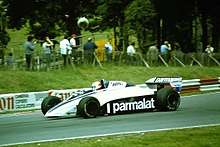
Next up was the inaugural Detroit Grand Prix, which was marred by lack of track preparation, delaying the practice session on a circuit that had never seen a motor race before. During the shortened qualifying, Prost took pole position ahead of de Cesaris, with Rosberg in third. The big surprise of the day was defending World Champion Piquet, who failed to qualify as his Brabham BT50 had engine problems and the spare car was not performing well either. In the race, Prost led comfortably until an accident between Roberto Guerrero, Elio de Angelis and Patrese led to the race being suspended. De Cesaris had retired at this point and at the restart, Prost led Rosberg and Pironi. A problem with the fuel injection slowed Prost down, handing the lead to Rosberg. John Watson, who qualified just 17th on the grid, had his Michelin tyres perform very well and overtook one driver after another until, on lap 37, he went into the lead, as Rosberg had gearbox issues. Watson won the race from Eddie Cheever and Pironi, taking the lead in the World Championship.[88][89]
Tragedy struck again at the Canadian Grand Prix. Pironi qualified on pole, but stalled at the start. His stationary car was hit by the Osella of young Italian Riccardo Paletti, who competed in only his second race in Formula One. Paletti suffered severe internal injuries and his car caught fire while the track marshals tried to extract him from his vehicle. He was pronounced dead upon arrival in the hospital. The race was restarted and won by Piquet in the BMW-powered Brabham ahead of teammate Patrese, still in the Cosworth-powered BT49D. Watson finished third to consolidate his lead in the championship.[90] After the Canadian round, Watson was on 30 points, ten ahead of Pironi, followed by Patrese on 19, Prost with 18 and Rosberg with 17 points.[91]
Back to Europe
At the Dutch Grand Prix, Ferrari introduced Patrick Tambay as a replacement for Villeneuve. The Renault drivers once more locked out the front row, Arnoux ahead of Prost. The latter took the lead at the start, followed by Arnoux and Pironi. On lap two, Pironi overtook Arnoux and three laps later moved ahead of Prost into the lead. While Prost retired with an engine failure, Arnoux was lucky to survive a heavy accident on lap 22 at Tarzan corner. His left front wheel broke off as he approached the corner, sending his car into the tyre wall. Pironi won the race without serious competition, ahead of Piquet and Rosberg.[92][93]
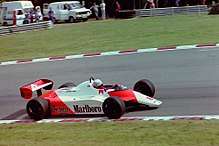
For the next race at Brands Hatch, the British Grand Prix, Brabham had devised what they referred to as "The Ploy". Inspired by Prost's comeback drive at the season opener at Kyalami, the team planned to send out their cars with tanks only half full and softer, and therefore faster, tyres. A pit stop midway through the race was supposed to refuel the car and change tyres, giving the Brabham drivers the advantage to be able to lap quicker than everybody else and gain enough of a lead to win.[94] In qualifying however, Rosberg surprised by taking only the second, and last, non-turbocharged pole position of the season. At the start of the warm-up lap, a fuel pressure issue led to his car being stationary. His mechanics helped him to a push start, but he did not reach the field in time and had to start the race last. This handed the front starting spot to Patrese, but he stalled. Both Arnoux and Fabi ran into him, taking all three out on the spot. Piquet as the only remaining Brabham left led from Lauda, but "The Ploy " was not to be executed, as Piquet retired with fuel injections problems on lap ten. This left Lauda to take his second victory of the season, followed by Pironi and Tambay. Pironi took over the lead of the championship, now five points ahead of Watson.[95][96]
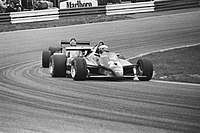
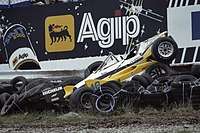
The Renaults were dominant at their home race, the French Grand Prix at Circuit Paul Ricard. Arnoux qualified ahead of Prost, and with Prost being better positioned in the championship, the team decided that if the cars should run first and second, he should win. Arnoux did not honour the agreement and took the victory ahead of his teammate, much to Prost's dismay. Another heavy accident marred the race, as Mass ran into the back of Mauro Baldi at Signes corner. As Mass's car slid towards the barrier, it was catapulted into the grandstands full of spectators. Although several people had minor injures, the accident left no one dead or even seriously injured.[97][98][99] At this stage, Pironi led the championship by nine points ahead of Watson[100] and was seen as the likely favourite to win the title.[24]
At the following event, the German Grand Prix at Hockenheim, Pironi qualified on pole position. However, later in the session he collided with Prost's Renault in wet conditions. His car was thrown into the air and while he survived the impact, he suffered severe leg injuries and would never compete in Formula One again.[101] The race took place with the first slot on the grid vacant.[102] Brabham were again attempting to employ the strategy of having their cars refuel and change tyres halfway through the race. Piquet led comfortably when he collided with Eliseo Salazar while trying to lap him, leading Piquet to furiously hit and kick his competitor after he got out of the car. Patrick Tambay went on to win the race for Ferrari, ahead of Arnoux and Rosberg, who was now third in the championship.[103][104]
At the Austrian Grand Prix on the Österreichring, most turbocharged runners retired early, leaving Prost in the lead, only to retire with fuel injection issues five laps from the finish.[105] This left Elio de Angelis and Rosberg to fight out the race victory, with de Angelis reaching the finish line 0.050 seconds ahead to win his first ever Grand Prix.[106][107] The Grand Prix also saw the Brabham drivers make it to their mid-race pit stops for the first time, only for both to retire later on.[108]
Rosberg in turn achieved his maiden victory at the next race, the Swiss Grand Prix, held at the Dijon-Prenois circuit. The Renaults of Prost and Arnoux had qualified in the front row. Rosberg, consistently lapping quicker than all other drivers, was held up by de Cesaris, but eventually found a way past him. He overtook Arnoux on lap 73 of 80 and Prost on lap 78 to take the lead and the race victory. In doing so, he also took the lead in the championship.[109][110]
At the Italian Grand Prix, Mario Andretti returned to take over the seat at Ferrari left vacant by Pironi and qualified in pole position. The race was won by Arnoux, leading home the Ferraris of Tambay and Andretti. Rosberg did not score points, having finished eighth.[44] John Watson meanwhile took three points for fourth place, leaving him with a mathematical chance of winning the title, in case he won the last race of the season and Rosberg failed to score.[111]
Last round and title decision
FISA circuit inspector Derek Ongaro speaking about the 1982 season.[112]
At the last race of the season, the Caesars Palace Grand Prix in Las Vegas, held in 98.8 °F (37.1 °C) degree weather during a particularly unsuitable and hot time of year in Las Vegas, Prost took pole position ahead of Arnoux. While Arnoux retired, Prost was hampered by blistering tyres to finish fourth. Michele Alboreto took a surprising victory for Tyrrell. Watson finished second, meaning that Rosberg's fifth-place finish was enough to secure the title.[113][114] He became the first driver since Mike Hawthorn in 1958 to clinch the championship having won just one Grand Prix.[115] The 1982 season was the last for Lotus team owner Colin Chapman, who passed away on 16 December 1982 having suffered a heart attack.[112] Following "a season touched by tragedy, clouded in controversy and enveloped in excitement",[24] FISA announced that the "ground effect" would be banned for 1983 to make the cars safer.[112] Overall, the 1982 season saw eleven different winners in 16 races, with no driver scoring more than two victories.[24] This included nine different winners in the same number of consecutive races.[116] Five drivers scored their first ever Grand Prix victory: Patrese, Tambay, de Angelis, Rosberg, and Alboreto.[24]
Results and standings
Grands Prix
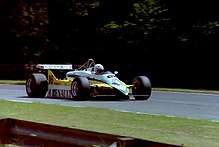
| Rnd | Race | Pole Position | Fastest Lap | Race Winner | Constructor | Report |
|---|---|---|---|---|---|---|
| 1 | Report | |||||
| 2 | Report | |||||
| 3 | Report | |||||
| 4 | Report | |||||
| 5 | Report | |||||
| 6 | Report | |||||
| 7 | Report | |||||
| 8 | Report | |||||
| 9 | Report | |||||
| 10 | Report | |||||
| 11 | Report | |||||
| 12 | Report | |||||
| 13 | Report | |||||
| 14 | Report | |||||
| 15 | Report | |||||
| 16 | Report | |||||
| Source:[117] | ||||||
Scoring system
Points were awarded to the top-6 classified finishers.[118] The best eleven results from all the races counted towards the Drivers' Championship.[34]
| Position | 1st | 2nd | 3rd | 4th | 5th | 6th |
|---|---|---|---|---|---|---|
| Points | 9 | 6 | 4 | 3 | 2 | 1 |
World Drivers' Championship standings
|
| |||||||||||||||||||||||||||||||||||||||||||||||||||||||||||||||||||||||||||||||||||||||||||||||||||||||||||||||||||||||||||||||||||||||||||||||||||||||||||||||||||||||||||||||||||||||||||||||||||||||||||||||||||||||||||||||||||||||||||||||||||||||||||||||||||||||||||||||||||||||||||||||||||||||||||||||||||||||||||||||||||||||||||||||||||||||||||||||||||||||||||||||||||||||||||||||||||||||||||||||||||||||||||||||||||||||||||||||||||||||||||||||||||||||||||||||||||||||||||||||||||||||||||||||||||||||||||||||||||||||||||||||||||||||||||||||||||||||||||||||||||||||||||||||||||||||||||||||||||||||||||||||||||||||||||||||||||||||||||||||||||||||||||||||||||||||||||||||||||||||||||||||||||||||||||||||||||||||||||||||||||||||||||||||||||||||||||||||||||||||||||||||||||||||||||||||||||||||||||||||||||||||||||||||||||||||||||||||||||||||||||||||||||||
World Constructors' Championship standings
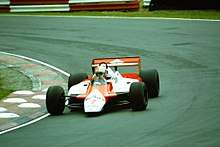

| Pos | Manufacturer | RSA |
BRA |
USW |
SMR |
BEL |
MON |
DET |
CAN |
NED |
GBR |
FRA |
GER |
AUT |
SUI |
ITA |
CPL |
Pts |
|---|---|---|---|---|---|---|---|---|---|---|---|---|---|---|---|---|---|---|
| 1 | Ret | Ret | DSQ | 2 | DNS | 8 | 3 | 4 | 1 | 4 | DNS | 2 | DNS | 74 | ||||
| 18 | 6 | Ret | 1 | DNS | 2 | 3 | 9 | 1 | 2 | 3 | DNS | 3 | Ret | |||||
| 2 | 6 | 2 | 6 | 1 | Ret | 1 | 3 | 9 | Ret | Ret | Ret | 9 | 13 | 4 | 2 | 69 | ||
| 4 | Ret | 1 | DSQ | Ret | Ret | Ret | 4 | 1 | 8 | DNS | 5 | 3 | Ret | Ret | ||||
| 3 | 1 | 1 | Ret | Ret | Ret | 7 | NC | Ret | Ret | 6 | 2 | Ret | 8 | 2 | Ret | 4 | 62 | |
| 3 | Ret | Ret | Ret | Ret | Ret | 10 | Ret | Ret | Ret | 1 | 2 | Ret | 16 | 1 | Ret | |||
| 4 | 2 | Ret | Ret | Ret | 6 | 5 | 7 | 5 | 5 | 7 | Ret | Ret | 9 | Ret | 6 | 58 | ||
| 5 | DSQ | 2 | 2 | Ret | 4 | Ret | 3 | Ret | 5 | 3 | 2 | 1 | 8 | 5 | ||||
| 5 | 8 | Ret | 5 | 4 | 5 | Ret | 4 | Ret | 4 | Ret | Ret | 1 | 6 | Ret | Ret | 30 | ||
| Ret | 3 | 7 | Ret | 4 | Ret | Ret | DNQ | Ret | 12 | 9 | Ret | 8 | 7 | Ret | ||||
| 6 | 7 | 4 | 4 | 3 | Ret | 10 | Ret | Ret | 7 | Ret | 6 | 4 | Ret | 7 | 5 | 1 | 25 | |
| 16 | 7 | 10 | Ret | Ret | 8 | 9 | NC | Ret | 8 | 10 | 7 | Ret | 11 | Ret | 8 | |||
| 7 | Ret | 5 | Ret | DNQ | 1 | 2 | Ret | Ret | Ret | Ret | 4 | Ret | Ret | 22 | ||||
| Ret | Ret | 15 | Ret | Ret | Ret | Ret | 5 | Ret | Ret | |||||||||
| 8 | Ret | Ret | Ret | 3 | Ret | 2 | 10 | DNQ | Ret | 16 | Ret | Ret | Ret | 6 | 3 | 20 | ||
| Ret | Ret | Ret | 9 | Ret | 6 | Ret | Ret | Ret | 14 | Ret | 3 | Ret | Ret | Ret | ||||
| 9 | DSQ | Ret | 19 | |||||||||||||||
| Ret | 3 | 1 | Ret | 2 | ||||||||||||||
| 10 | 13 | Ret | Ret | Ret | Ret | 3 | Ret | 6 | Ret | Ret | Ret | Ret | Ret | 10 | 10 | 9 | 7 | |
| 11 | Ret | Ret | Ret | Ret | Ret | Ret | Ret | 11 | 7 | 9 | 5 | Ret | 12 | Ret | 10 | |||
| 11 | DNQ | DNQ | Ret | 7 | 9 | 8 | 5 | 10 | Ret | 13 | 6 | Ret | 15 | Ret | 7 | 5 | ||
| DNQ | 10 | DNQ | Ret | DNQ | Ret | 8 | 6 | 9 | Ret | Ret | 6 | DNQ | 12 | 11 | ||||
| 12 | 10 | 5 | Ret | DSQ | Ret | Ret | Ret | DNQ | 12 | DNQ | 11 | Ret | Ret | Ret | DNQ | NC | 4 | |
| 9 | Ret | Ret | 5 | Ret | Ret | Ret | Ret | 13 | DNQ | Ret | Ret | DNQ | 14 | 9 | DNQ | |||
| 13 | Ret | 9 | Ret | 4 | Ret | DNQ | Ret | Ret | 14 | Ret | Ret | Ret | DNQ | Ret | Ret | DNS | 3 | |
| DNQ | DNPQ | DNQ | Ret | DNPQ | DNPQ | DNS | Ret | |||||||||||
| 14 | 17 | Ret | DNQ | 6 | DNPQ | 11 | DNQ | Ret | Ret | DNQ | 11 | 7 | DNQ | 11 | DNQ | 1 | ||
| — | 12 | 8 | 8 | Ret | DNQ | 7 | 11 | Ret | 10 | Ret | DNQ | Ret | Ret | DNQ | 12 | 0 | ||
| 15 | Ret | 9 | 8 | DNPQ | Ret | Ret | Ret | DNQ | DNQ | Ret | DNQ | Ret | DNQ | 13 | ||||
| DNPQ | DNPQ | DNQ | DNQ | DNPQ | ||||||||||||||
| — | WD | DNQ | Ret | DNQ | DNQ | Ret | Ret | DNQ | Ret | DNQ | 8 | Ret | Ret | NC | DNS | 0 | ||
| — | Ret | DNQ | DNPQ | Ret | Ret | DNQ | Ret | Ret | 15 | 10 | Ret | Ret | Ret | Ret | 0 | |||
| DNQ | DNQ | DNQ | NC | Ret | DNPQ | DNQ | Ret | Ret | DNQ | Ret | Ret | Ret | DNQ | |||||
| — | 14 | Ret | Ret | DNQ | DNQ | DNQ | Ret | Ret | DNQ | DNQ | DNQ | Ret | DNQ | DNQ | Ret | 0 | ||
| Pos | Constructor | RSA |
BRA |
USW |
SMR |
BEL |
MON |
DET |
CAN |
NED |
GBR |
FRA |
GER |
AUT |
SUI |
ITA |
CPL |
Pts |
| Source:[120] | ||||||||||||||||||
Notes
- Former world champions Jackie Stewart and James Hunt were rumoured to return to the sport at the end of the 1981 season.[5]
- In 2015, Switzerland partially lifted the ban on motor racing, but just for fully-electric vehicles, such as Formula E.[28]
- Lang gives the FISA teams in 1980 as "Ferrari, Renault, Alfa-Romeo, Talbot-Ligier and Osella". By April 1982, Toleman has been added to the list, but "Guy Ligier had recently switched allegiance to FOCA".[33]
- The exemption to this rule was the Monaco Grand Prix, where only 20 cars were allowed to take the start, due to the narrow nature of the track.[5]
- Jochen Mass did not partake in the strike and Teo Fabi left it mid-way due to pressure from his team.[53]
- The Tyrrell team, although a member of FOCA, attended the event. They were exempted from the boycott due to Italian sponsors providing much-needed money for the team.[72]
References
- Roebuck 1999, p. 170.
- Hilton 2007, p. 23.
- Jenkinson, Denis. "The Formula One Scene". Motor Sport (February 1982): 26. Archived from the original on 21 January 2018. Retrieved 21 January 2018.
- Nye 1986, p. 112.
- Jenkinson, Denis. "The Formula One Scene". Motor Sport (January 1982): 31. Archived from the original on 21 January 2018. Retrieved 21 January 2018.
- Hilton 2007, p. 18.
- Lewin, Ignacio (1 April 1982). "Carlos Reutemann se retira y le sustituye Mario Andretti". El País (in Spanish). Archived from the original on 21 January 2018. Retrieved 21 January 2018.
- Hilton 2007, p. 13.
- Lang 1992, p. 75.
- Hilton 2007, pp. 18–19.
- Hilton 2007, p. 21.
- Hilton 2007, pp. 29 & 39.
- "Kyalami F1 testing". Motor Sport (February 1982): 58. Archived from the original on 21 February 2018. Retrieved 21 February 2018.
- Hilton 2007, p. 83.
- Hilton 2007, p. 246.
- Hilton 2007, p. 156.
- Hilton 2007, pp. 156 & 162.
- Jenkinson, Denis. "The French Grand Prix". Motor Sport (September 1982): 107. Archived from the original on 21 January 2018. Retrieved 21 January 2018.
- Pappone, Jeff (7 May 2012). "F1 driver Mass explains why he quit racing after fatal Villeneuve crash". The Globe and Mail. Archived from the original on 22 January 2018. Retrieved 22 January 2018.
- "Rupert Keegan". Motor Sport. Archived from the original on 22 January 2018. Retrieved 22 January 2018.
- "Slim Borgudd". Motor Sport. Archived from the original on 22 January 2018. Retrieved 22 January 2018.
- Jenkinson, Denis. "Grote Prijs van Belgie". Motor Sport (June 1982): 46. Archived from the original on 22 January 2018. Retrieved 22 January 2018.
- "1982 Race Results". formula1.com. Formula One World Championship Limited. Archived from the original on 2 February 2018. Retrieved 2 February 2018.
- Pye, Steven (14 October 2013). "Remembering the tragedy and mayhem of the 1982 F1 World Championship". The Guardian. Archived from the original on 21 January 2018. Retrieved 21 January 2018.
- Collantine, Keith (21 June 2011). "30 years ago: Villeneuve's last and best F1 win". F1Fanatic. Archived from the original on 21 January 2018. Retrieved 21 January 2018.
- Jenkinson, Denis. "The 1982 International Racing Season". Motor Sport (February 1982): 35. Archived from the original on 21 January 2018. Retrieved 21 January 2018.
- Jenkinson, Denis. "The Formula One Scene". Motor Sport (March 1982): 32. Archived from the original on 21 January 2018. Retrieved 21 January 2018.
- Baldwin, Alan (21 September 2017). "Motor racing: Switzerland to host first race in more than 60 years". Reuters. Archived from the original on 17 March 2018. Retrieved 17 March 2018.
- Larson, Mike (12 November 2012). "U.S. Grand Prix history review as Austin prepares for Formula One". Autoweek. Archived from the original on 23 January 2018. Retrieved 23 January 2018.
- Diepraam, Mattijs (21 November 2007). "Poachers turned gamekeepers: how the FOCA became the new FIA". forix.com. Haymarket Media Group. Archived from the original on 28 January 2018. Retrieved 28 January 2018.
- Saward, Joe (1 September 1993). "Why has FISA been abolished?". grandprix.com. Archived from the original on 28 January 2018. Retrieved 28 January 2018.
- "FISA/FOCA war". autosport.com. 1 June 1980. Archived from the original on 28 January 2018. Retrieved 28 January 2018.
- Lang 1992, pp. 10 & 92.
- Smith 2013, p. 277.
- Trzesniowski, Michael (2010). Rennwagentechnik: Grundlagen, Konstruktion, Komponenten, Systeme (in German). Wiesbaden: Vieweg+Teubner Verlag. p. 135. ISBN 978-3834808578.
- "Re-writing the F1 rule book – Part 1: from wing cars to flat bottoms". formula1.com. Formula One World Championship Limited. 3 February 2017. Archived from the original on 22 January 2018. Retrieved 22 January 2018.
- Smith 2013, p. 266.
- Malsher, David. "A year on the edge". Motor Sport (February 2002): 22. Archived from the original on 22 January 2018.
- Collantine, Keith (7 June 2007). "Banned: Ground effect". F1Fanatic. Archived from the original on 22 January 2018. Retrieved 22 January 2018.
- Hilton 2007, pp. 49 & 51.
- Collantine, Keith (2 July 2011). "Renault RS01: F1's turbo pioneer". F1Fanatic. Archived from the original on 22 January 2018. Retrieved 22 January 2018.
- Hilton 2007, pp. 16–17.
- Nye 1986, p. 147.
- Jenkinson, Denis. "The Italian Grand Prix". Motor Sport (October 1982): 46. Archived from the original on 21 January 2018. Retrieved 21 January 2018.
- "Ford-Cosworth DFV: Eine Ikone der Formel-1-Motoren wird 50". motorsport-total.com (in German). 27 March 2017. Archived from the original on 22 January 2018. Retrieved 22 January 2018.
- "Case study: Carbon Fibre". McLaren. Archived from the original on 22 January 2018. Retrieved 22 January 2018.
- Pritchard, Anthony (2015). Grand Prix Ford: Ford, Cosworth and the DFV. Poundbury: Veloce Publishing Ltd. p. 115. ISBN 978-1845846244.
- Hilton 2007, pp. 52–54.
- Roebuck 1999, pp. 175–176.
- Hilton 2007, p. 29.
- Hilton 2007, p. 27.
- Hilton 2007, pp. 24–28.
- Hilton 2007, pp. 31 & 37.
- Hilton 2007, pp. 30–38 & 46.
- Roebuck 1999, pp. 173–175.
- Hilton 2007, pp. 39–43.
- Lang 1992, pp. 82–84.
- Jenkinson, Denis. "The South African Grand Prix". Motor Sport (March 1982): 36. Archived from the original on 2018-08-27. Retrieved 27 August 2018.
- Lang 1992, p. 85.
- Roebuck 1999, p. 175.
- Hilton 2007, pp. 50–52.
- "Brazilian Grand Prix". Motor Sport (April 1982): 70. Archived from the original on 2018-08-27. Retrieved 27 August 2018.
- Lang 1992, pp. 84–88.
- Hilton 2007, p. 52.
- Hilton 2007, pp. 61–66.
- Jenkinson, Denis. "United States (West) Grand Prix". Motor Sport (May 1982): 46. Archived from the original on 2018-08-27. Retrieved 27 August 2018.
- Lang 1992, pp. 88–92.
- Lang 1992, p. 92.
- Hilton 2007, p. 71.
- Roebuck 1999, pp. 178–180.
- Hilton 2007, p. 67.
- Roebuck 1999, p. 180.
- Hilton 2007, pp. 68–79.
- Jenkinson, Denis. "The San Marino Grand Prix". Motor Sport (June 1982): 104. Archived from the original on 2018-08-27. Retrieved 27 August 2018.
- Donaldson 2003, pp. 289–290.
- Roebuck 1999, pp. 183.
- Hilton 2007, pp. 85–87.
- Lang 1992, pp. 96–97.
- Watkins 1997, p. 98.
- Donaldson 2003, pp. 296–298.
- "Belgian Grand Prix". Motor Sport (June 1982): 88. Archived from the original on 2018-08-27. Retrieved 27 August 2018.
- Bamsey 1983, p. 51.
- Roebuck 1999, p. 186.
- Roebuck 1999, p. 187.
- Lang 1992, pp. 99–102.
- Jenkinson, Denis. "The Monaco Grand Prix". Motor Sport (July 1982): 62. Archived from the original on 2018-08-27. Retrieved 27 August 2018.
- Bamsey 1983, p. 57.
- Jenkinson, Denis. "The Grand Prix of Detroit". Motor Sport (July 1982): 43–47. Archived from the original on 6 March 2018. Retrieved 6 March 2018.
- Lang 1992, pp. 103–107.
- Jenkinson, Denis. "The Canadian Grand Prix". Motor Sport (July 1982): 48–50. Archived from the original on 6 March 2018. Retrieved 6 March 2018.
- Hilton 2007, p. 151.
- Hilton 2007, pp. 160–173.
- "Dutch GP, 1982". grandprix.com. Archived from the original on 2018-08-27. Retrieved 27 August 2018.
- Hilton 2007, pp. 174–178.
- Hilton 2007, pp. 182–189.
- "British GP, 1982". grandprix.com. Archived from the original on 2018-08-27. Retrieved 27 August 2018.
- Hilton 2007, pp. 194–201.
- Lang 1992, pp. 119–122.
- Jenkinson, Denis. "The French Grand Prix". Motor Sport (September 1982): 107. Archived from the original on 2018-08-27. Retrieved 27 August 2018.
- Hilton 2007, p. 201.
- Lang 1992, p. 123.
- Hilton 2007, p. 206.
- Hilton 2007, pp. 211–215.
- Jenkinson, Denis. "The German Grand Prix". Motor Sport (September 1982): 41. Archived from the original on 2018-08-27. Retrieved 27 August 2018.
- Lang 1992, p. 129.
- Hilton 2007, p. 227.
- "Austrian GP, 1982". grandprix.com. Archived from the original on 2018-08-27. Retrieved 27 August 2018.
- Roebuck 1999, pp. 211–212.
- Hilton 2007, pp. 238–241.
- "The Swiss Grand Prix". Motor Sport (October 1982): 42. Archived from the original on 2018-08-27. Retrieved 27 August 2018.
- Hilton 2007, pp. 246–257.
- Roebuck 1999, p. 217.
- "United States GP, 1982". grandprix.com. Archived from the original on 27 August 2018. Retrieved 27 August 2018.
- Hilton 2007, pp. 264–273.
- "Elegant champion: Hawthorn triumphs in F1 with style". ferrari.com. Scuderia Ferrari. Retrieved 7 March 2018.
- Lynch, Steven. "'Nine different winners in nine races' – Ask Steven". Ask Steven – ESPNF1.com. Archived from the original on 28 May 2012. Retrieved 23 January 2016.
- "1982 Race Results". formula1.com. Formula One World Championship Limited. Archived from the original on 16 March 2018. Retrieved 16 March 2018.
- Higham, Peter (1995). The Guinness Guide to International Motor Racing. London: Motorbooks International. p. 6. ISBN 978-0760301524.
- "1982 Driver Standings". formula1.com. Formula One World Championship Limited. Archived from the original on 16 March 2018. Retrieved 16 March 2018.
- "1982 Constructor Standings". www.formula1.com. Formula One World Championship Limited. Archived from the original on 21 February 2018. Retrieved 9 December 2016.
Bibliography
- Bamsey, Ian (1983). Automobile Sport 82–83. Sparkford: Haynes Manuals. ISBN 0-946321-01-9.CS1 maint: ref=harv (link)
- Donaldson, Gerald (2003). Gilles Villeneuve. London: Virgin. ISBN 0-7535-0747-1.CS1 maint: ref=harv (link)
- Hilton, Christopher (2007). 1982: The inside story of an astonishing Grand Prix season. Newbury Park, CT; Sparkford: Haynes Publishing. ISBN 9781844254040.CS1 maint: ref=harv (link)
- Lang, Mike (1992). Grand Prix! Race-by-race account of Formula 1 World Championship motor racing. Vol. 4. Sparkford: Haynes Publishing. ISBN 0-85429-733-2.CS1 maint: ref=harv (link)
- Nye, Doug (1986). Autocourse history of the Grand Prix car 1966–85. Hazleton Publishing. ISBN 0-905138-37-6.CS1 maint: ref=harv (link)
- Roebuck, Nigel (1999). Chasing the Title. Memorable moments from fifty years of Formula 1. Sparkford: Haynes Publications. ISBN 1-85960-604-0.CS1 maint: ref=harv (link)
- Smith, Roger (2013). Formula 1: All the Races. The World Championship Story Race-by-Race 1950–2012 (2nd ed.). Sparkford: Haynes Publishing. ISBN 978 0 85733 350 6.CS1 maint: ref=harv (link)
- Watkins, Sid (1997). Life at the Limit: Triumph and Tragedy in Formula One. London: Pan Books. ISBN 0-330-35139-7.CS1 maint: ref=harv (link)
External links
| Wikimedia Commons has media related to 1982 in Formula One. |
- Result archive on the official Formula One website
- February 2002 issue of Motor Sport magazine, focusing on the 1982 season
